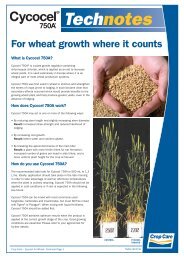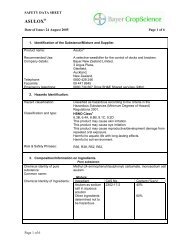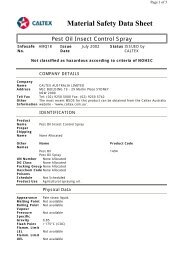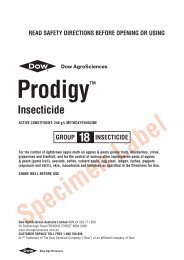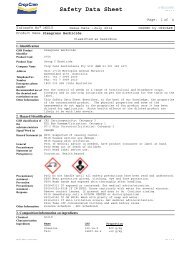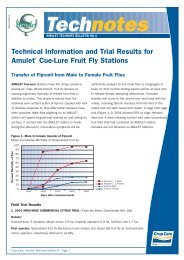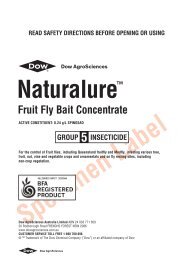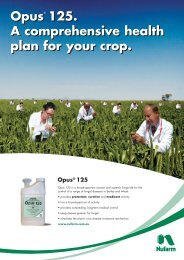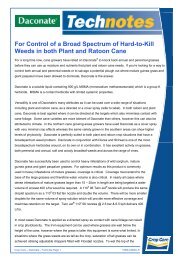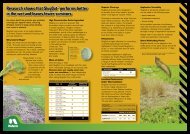Fastac Duo Technical Manual - Pest Genie
Fastac Duo Technical Manual - Pest Genie
Fastac Duo Technical Manual - Pest Genie
You also want an ePaper? Increase the reach of your titles
YUMPU automatically turns print PDFs into web optimized ePapers that Google loves.
Honey bees are frequently attracted to cereal crops<br />
where they forage honeydew secreted by<br />
aphids. Unlike nectar and pollen, which are<br />
n o rmally protected by flower petals, aphid<br />
honeydew is exposed and can be contaminated<br />
if the crop is sprayed.<br />
In the wheat study, bee hives were put inside large<br />
mesh covered tunnels placed over a crop of wheat.<br />
A sugar solution which simulated aphid honeydew<br />
was then sprayed on the crop. Once the bees were<br />
used to foraging the sugar solutions, insecticides<br />
were applied to two-thirds of the enclosed area. The<br />
rest was left untreated so the bees could choose it as<br />
an alternative area for foraging and thus show if they<br />
were repelled by any of the sprays which were used.<br />
The data 1 showed that none of the three dose rates of<br />
FA S TAC <strong>Duo</strong>, even the highest, which was up to<br />
three times the expected European commercial<br />
dose nor pirimicarb, produced any increase in bee<br />
mortality. Dimethoate, on the other had, caused<br />
large numbers of bee deaths - over 50 per cent of<br />
the total population of the hive. Residue levels of<br />
FASTAC <strong>Duo</strong> in honey and in wax collected from<br />
the hive exposed to two FASTAC <strong>Duo</strong> applications<br />
were very low.<br />
Foraging activity was greatly reduced in the areas of<br />
the tunnels treated with FA S TA C<strong>Duo</strong> or pirimicarb<br />
but it continued at almost normal levels in the part s<br />
of the tunnels which had not been treated, thus<br />
demonstrating the repellent effect of fresh deposits of<br />
these compounds. Foraging stopped in both the<br />
treated and the untreated parts of the tunnels<br />
sprayed with dimethoate † , but returned to norm a l<br />
after 24 hours.<br />
Beneficial Invert e b r a t e s<br />
The value of bees to man is well known, but there<br />
are many other useful invertebrates. Eart h w o rm s ,<br />
for example, improve soil fert i l i t y, while predatory<br />
and parasitic insects can help keep pests in check.<br />
Predator/prey systems range from simple<br />
relationships such as the use of the parasitic chalcid<br />
wasp, Encarsia form o s a , to control whitefly in<br />
glasshouses to relatively complex interactions<br />
between whole groups of predatory and plant-eating<br />
species of invertebrates found in large-scale arable<br />
crops. Whatever the case, it is clearly to man’s<br />
benefit to exploit the activities of useful species.<br />
E a rt h w o rm s<br />
The toxicity of FA S TA C<strong>Duo</strong> to<br />
e a rt h w o rms was assessed under<br />
l a b o r a t o ry conditions using a simple<br />
test method. The test involves keeping batches<br />
of worms for 14 days in a standard artificial soil into<br />
5<br />
which known concentrations of the test chemicals<br />
have been mixed. The worms are thus in direct<br />
bodily contact with the chemicals and they also ingest<br />
contaminated soil. By testing a chemical at a range of<br />
concentrations, mortality data can be used to<br />
calculate LC50 values.<br />
FA S TAC <strong>Duo</strong> was tested at various<br />
concentrations. Even at the highest rate, in<br />
the top millimetre of soil, no worms died.<br />
As this is higher than the highest Australian<br />
commercial dose rate, it seems safe to<br />
conclude that the normal use of<br />
FA S TAC <strong>Duo</strong> will not be a hazard to<br />
e a rt h w o rm populations.<br />
The Chalcid Wa s p<br />
The chalcid wasp, Trichogramma cacoeciae,<br />
parasitises the eggs of a range of Lepidoptera<br />
including arm y w o rms, bollworms and stalk borers<br />
such as Spodoptera, Heliothis and Ostrinia s p p .<br />
Trichogramma is one of the most successful of all<br />
a rthropod biological control agents. Laboratory<br />
reared specimens are used in mass release<br />
programmes to control pest populations.<br />
L a b o r a t o ry tests show that nearly all synthetic<br />
insecticides so far tested are highly toxic to adult<br />
chalcid wasps under laboratory conditions. In<br />
practice, crops are sprayed when many of the<br />
wasps are in the preadult stages is critical as far as<br />
the future population of the parasite is concern e d .<br />
A laboratory test was developed to compare the<br />
e ffects of FA S TA C <strong>Duo</strong> on preadult Tr i c h o g r a m m a<br />
with those of other widely used insecticides.<br />
1 - Reference: FA S TAC and the Environment, published 1983



